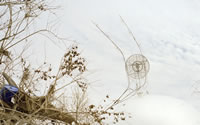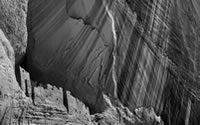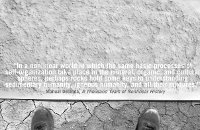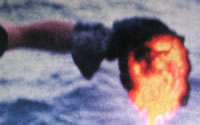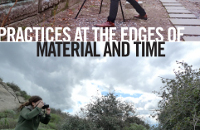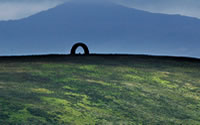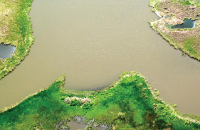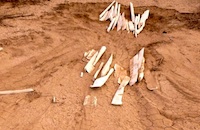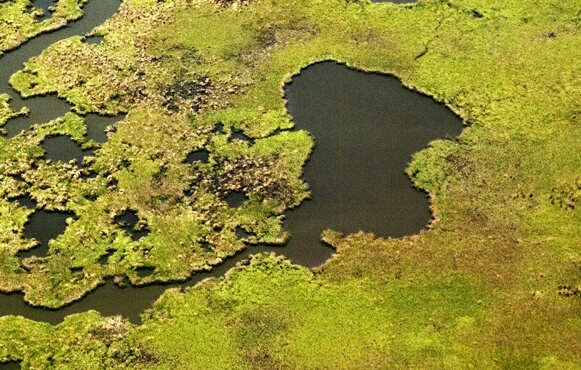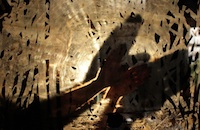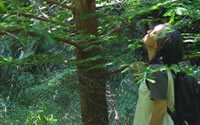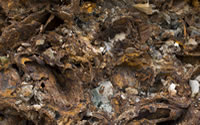Unconformities, Schisms and Sutures — Geology and the Art of Mythology in Scotland
Matt Baker + John GordonGeopoetics is concerned, fundamentally, with a relationship to the earth and with the opening of a world.

Photo: John Gordon
Opening New Worlds
In the late 18th century, James Hutton's insights opened new worlds, both geological and cultural. For the first time, human identity could be placed against a geological timescale, allowing the emergence of new mythologies. Hutton's theory, underpinned by the concept of geological "unconformity," the interruption in the "rock record" of the natural sequence of rocks, led to a new scientific and rational understanding of geology. That new understanding led to the questioning of creation mythologies through empirical science, creating senses of displacement or "unconformity" among people during the Enlightenment. Humans found their senses of self and their traditional mythologies displaced in relation to, or not conforming to, the notion of deep time.
As the science of Geology set about developing an empirical understanding of the "abyss of time" (as described by John Playfair) and reconstructing Earth history (the "worlds before Adam" in the words of Martin Rudwick), artists wrestled with a different problem: how to build new mythologies that situated humankind's sense of self in relationship to this longest of all time-signatures. The different historical responses we present here conclude with the production of "nonconformities" in the landscape by contemporary artists who are re-appropriating geologic science as the material for new mythologies that connect human time to deep time.
In acknowledging this threshold in the history of our relationship to landscape and the "abyss of time," it is useful to reflect on our fascination with the cultural understanding of geomorphology held within the mythologies of aboriginal societies. Perhaps we can begin to accept that the Enlightenment, while bringing new freedoms and possibilities, also left a void to fill: the need for a creative mythology of self in relation to the rocks:
. . . human experience in this difficult Northern place has been built so intimately into the geology and the post-glacial ecology of Scotland that a people and its stones form a single cultural landscape. (Neal Ascherson, 2002)
The Southern Uplands of Scotland form the geological context of this essay. Here, a narrow belt of elevated terrain runs across the country, marking both an ancient suture and the political boundary with England. The feature was formed 425 million years ago when the crustal fragments that would become Scotland collided and fused with one another as a result of the movements of the Earth's tectonic plates. Hutton's Unconformity at Siccar Point lies at the eastern extremity of the Southern Uplands.
In considering the time-span from the Scottish Enlightenment of the mid to late 18th century until the present day, we propose three eras of artistic mythology in landscape: "Tourism of Awe," "Mechanics of Conquest" and "Search for New Unconformity."
back to top ↑The Tourism of Awe
The Romantic Movement and the quest to experience sublime and picturesque landscapes during the late 18th and early 19th centuries were influenced by the aesthetic values expressed by Thomas Burnet, Joseph Addison, Edmund Burke, William Gilpin, and others. Enlightenment questioning of divine creation as the definitive generator of landscape allowed artists, poets, and writers to re-discover a new awe in the "works" of nature which they contrasted with the works of man. This ability to speculate about unknown but unquestionably awesome creative forces at work in nature presented the challenge to artists to redefine the scale of landscape in relation to mankind--not as something else made by the same benevolent creative hand, but rather, as something "other," something that was literally perilous to contemplate. One such example is the Falls of Clyde (the source of the River Clyde is on the Southern Uplands) where:
. . . you are struck at once with the aweful scene which suddenly bursts upon your astonished sight. Your organs of perception are hurried along, and partake of the turbulence of the roaring waters. The powers of recollection remain suspended, for a time, by this sudden shock; and it is not till after a considerable time, that you are enabled to contemplate the sublime horrors of this majestic scene. (Thomas Newte [William Thomson], 1788)back to top ↑
The Mechanics of Conquest
With the Industrial Revolution, humans acquired the ability to engineer and shape the landscape, building railways, canals, bridges, and tunnels in a manner unthinkable to the Romantic poets. This ability often turned geology from something inducing awe instead into a series of challenges that could be overcome through human ingenuity and powerful new machinery. This was also the age that gave birth to the first "science fiction." In its incomparable durability and longevity, geology became one of the ultimate contexts against which human achievements and ingenuity could be measured. A romantic age of science offered a human myth of conquering time. Jules Verne claimed Scottish ancestry and spent time touring the country--his science fiction novel The Underground City is based in The Trossachs at Aberfoyle. In it, he imagines a community living underground in an abandoned coal mine beneath great loch and rivers.
In central and southern Scotland this era expressed itself in the landscape through the growing spoil heaps of oil shale and coalmining and the systematic "clearance" of indigenous crofting culture from the land to make way for industrial sheep husbandry for wool production. Artistically, the "Mechanics of Conquest" evolved from the confidence of power into a period of questioning and metaphorical use of the landscape to express concerns about the human condition, as in the poetry of Hugh MacDiarmid, Sorley MacLean, Norman MacCaig and Ian Crichton Smith:
Who possesses this landscape?
The man who bought it or
I who am possessed by it?
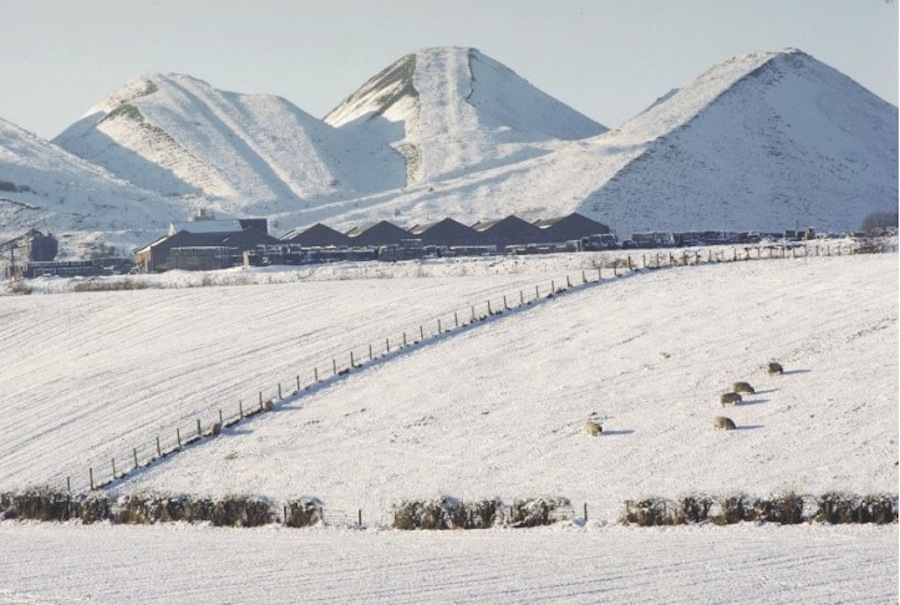
Photo: Lorne Gill/Scottish Natural Heritage
The Search for New Unconformity: the Southern Uplands
In the most recent era we identify a shift from artists speculating on landscape at one remove to working directly in and with landscape. We see this "Search for New Unconformity" as a strategy to use landscape and geomorphological processes as a framework to question the schisms of specialisation and embrace a process that restructures a mythology of mankind as part of the land.
One of the methods employed by contemporary artists is to creatively re-appropriate the scientific processes of geology as a new mythology inviting humans today to re-place themselves in the context of immeasurable time signatures. These new "unconformities" placed deliberately and unceremoniously within the public landscape re-interpret the language of science to re-assert our understanding of ourselves as part of the geologic as a living system, a concept originally embraced by James Hutton in his Theory of the Earth. This mirrors the calls to reconnect with the natural world and rediscover a sense of wonder. Ultimately, in the words of the Scottish poet and internationalist, Hugh MacDiarmid:
We must reconcile ourselves to the stones,
Not the stones to us.
Projects
1. Shinglehook, Matt Baker 2006
At one of the highest elevations in the Southern Upland, St. Marys Loch was a significant inspiration to Romantic poets such as Wordsworth, Scott, Hogg and Burns. Shinglehook is a "permanent" installation in the landscape that is part time-based experiment and part romantic speculation in futility.
The Meggat Water (river) enters St Marys Loch on the northern shore. The slowing of the river causes the water to release the solid material that it has picked up on its journey down the glen; this deposited material is forming a new spit of land that will eventually divide St. Marys Loch in two. It is estimated that the process will take 10,000 years to complete.
Shinglehook is conceived as a "place to wait for geology"--four bronze castings were made from a mould taken from the furthest tip of the growing alluvial land bridge. These metal casts float in a line projecting out from the southern shore towards the Meggat Water; the casts can move laterally but are anchored to the shore via cabling secured by two oak drag anchors. The oak anchors are half buried in the shale shore; free to move with changes to the shape of the land, their form will, ultimately, keep them gripped by the substance of the shale.
The viewer is invited to speculate that, one day, the bronze casts will be enveloped by the arrival of the land bridge across the loch and the mobile structure of Shinglehook will become static.
The materials of Shinglehook cannot possibly last 10,000 years unaided. Either the project will require the support of people in the future to maintain and renew it, or, it will gradually disintegrate and be dispersed in the landscape. In recent years the work was saved by a passing visitor who extinguished a fire in one of the oak anchors (the local authority then paid for the timber to be repaired) and the local sailing club has begun to monitor the condition of the bronze floats and report any issues to the artist.

Clockwise from top: Overall view looking towards the Meggat Water; Oak anchors half-buried in the shale; Bronze casts floating on the loch.
Photos: Allan Devlin
2. Striding Arches, Andy Goldsworthy 2009
Andy Goldsworthy is an internationally renowned artist working directly in the landscape--his home and studio are in the Southern Uplands of Scotland. He has made many small interventions in the local landscape, but in 2009 completed his first major work for the area, Striding Arches. Crucial to Goldsworthy's selection of sites was his stipulation that no matter which arch you find yourself at, you should always be able to see the other two: the three arches are linked together by sightlines.
The overall work comprises a small building for community events and a challenging hillwalk around all the arches.
Striding Arches is part of a worldwide project of Goldsworthy's that uses arches made from Dumfriesshire sandstone to highlight the Scottish diaspora. He has constructed arches in Canada, New Zealand and USA, echoing the travels of emigrating Scots over the last 200 years or so, and of the sandstone carried as ballast by timber ships making the return voyage to North America:
The stone is a potent symbol of the Scots who went abroad of the tremendous upheaval they made, or were forced to make, when they left Scotland… I would hope that collectively these arches are a celebration and monument to the Scottish people and the travels they have made, and that they will act as a connection between those who have left and those who have stayed here. (Andy Goldsworthy)
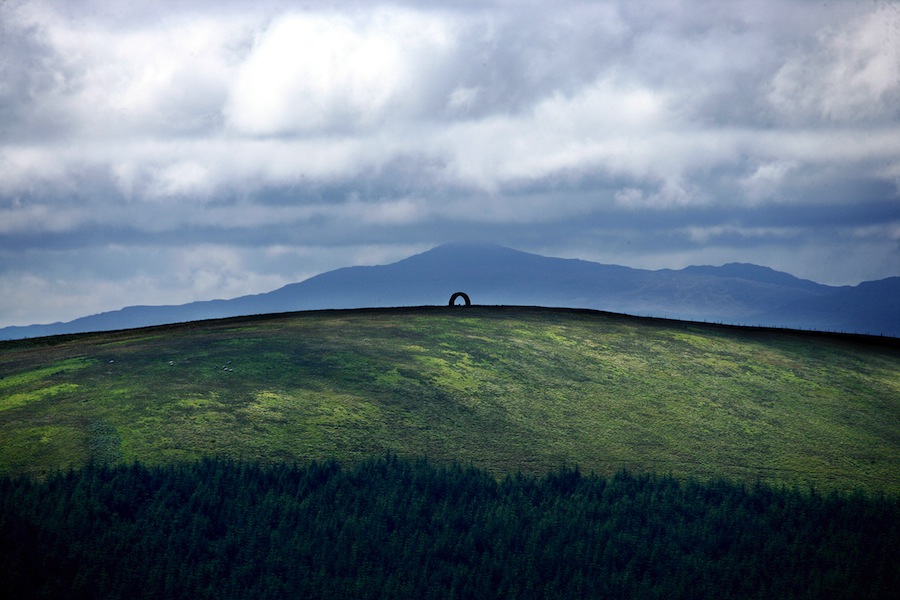
One of three self-supporting 4m high arches in the landscape. A fourth grows from a traditional stone byre.
Photo: Mike Bolam
3. Erratic, Matt Baker 2008
Erratic is one of 5 time-based works by the artist, "permanently" installed in the Southern Uplands on the slopes of Cairnsmore of Fleet. The area is a National Nature Reserve (maintained by Scottish Natural Heritage) and is particularly noted for the clear evidence of geological processes, including tectonic plate suturing, later granitic intrusions, and extensive glaciation.
Matt Baker collaborated with locally-based poet, Mary Smith, and each work comprises a poem and a physical installation. Sited in one of the most remote and beautiful parts of the landscape, Erratic is on a journey. The background information about the project invites anyone finding Erratic to move the sculpture to a location of their choosing; the bronze pulling-handle can be drawn from the carved granite boulder and used to physically drag the stone over the landscape. Erratic was originally placed approximately 3 miles from the nearest road and is situated in approximately 10,000 acres of open country.
Erratic* (Mary Smith, 2007)
A’m no keen oan bein cried an ‘erratic’:
soons as though A staggert here,
stottin fu. Tellin ye, it wisnae me:
a big glacier did it –
an then it meltet away.
A wisnae daein nothin wrang whin
it gied me a shove, wheeched me up,
whirled me aroon lik A wis
nae mair wechtie nor a balloon.
Next meenit, heid ower heels,
breengin doon thon hill.
* An erratic is a boulder transported and deposited by a glacier. They are useful indicators of patterns of former ice flow.
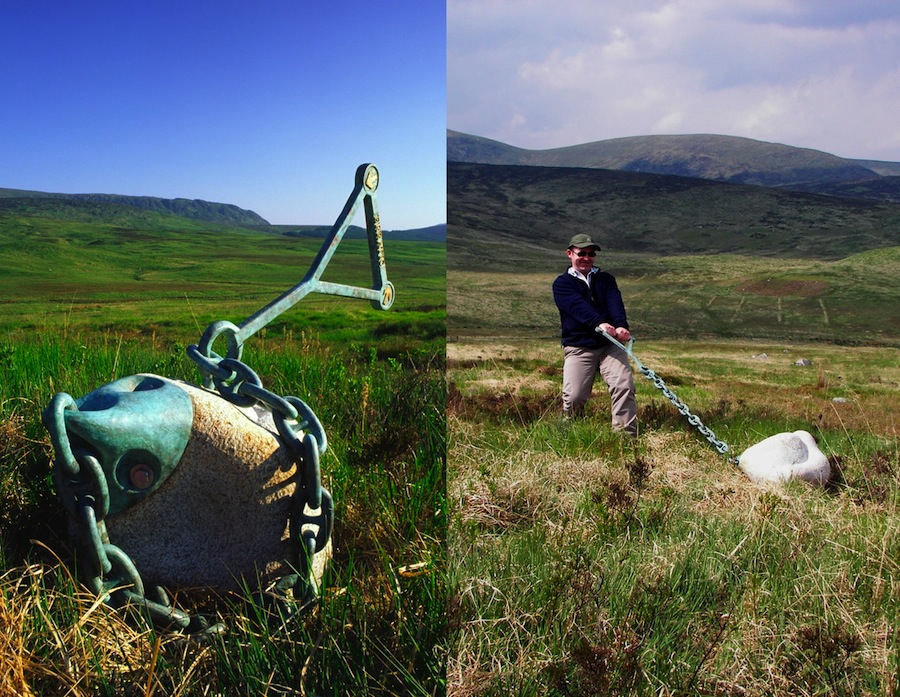
Bronze chain, pulling handle and fixing on carved granite boulder weighing approximately 100 lbs.
Photos: Matt Baker
References
- Ascherson, Neal. 2002. Stone Voices. London: Granta.
- Goldsworthy, Andy. 2009. Striding Arches: http://www.stridingarches.com.
- Hutton, J. 1788. “Theory of the Earth; or an investigation of the laws observable in the composition, dissolution, and restoration of land upon the globe,” Transactions of the Royal Society of Edinburgh, Vol. 1: 209-304.
- MacCaig, Norman. 1990. Collected Poems. London: Chatto & Windus.
- MacDiarmid, Hugh. 2002. Selected Poems. Manchester, UK: Carcanet.
- Newte, T. [William Thomson]. 1788. A Tour in England and Scotland, in 1785. London: G.G.J and J. Robinson.
- Playfair, J. 1805. “Biographical account of the late Dr James Hutton, F.R.S. Edin.,” Transactions of the Royal Society of Edinburgh, Vol. 5: 39-99.
- Rudwick, M.J.S. 2008. Worlds Before Adam. The Reconstruction of Geohistory in the Age of Reform. Chicago: University of Chicago Press.
- White, K. 2003. Geopoetics: Place, Culture, World. Glasgow: Alba Editions.
